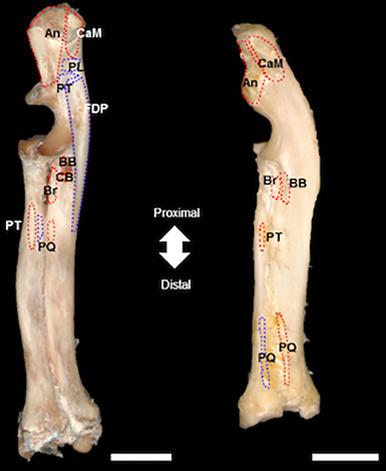当前位置:
X-MOL 学术
›
J. Morphol.
›
论文详情
Our official English website, www.x-mol.net, welcomes your
feedback! (Note: you will need to create a separate account there.)
Comparative forelimb morphology of scratch‐digging and chisel‐tooth digging African mole‐rat species
Journal of Morphology ( IF 1.5 ) Pub Date : 2020-06-26 , DOI: 10.1002/jmor.21229 Narusa S Doubell 1 , Lauren Sahd 1 , Sanet H Kotzé 1
Journal of Morphology ( IF 1.5 ) Pub Date : 2020-06-26 , DOI: 10.1002/jmor.21229 Narusa S Doubell 1 , Lauren Sahd 1 , Sanet H Kotzé 1
Affiliation

|
Bathyergus suillus (Cape dune mole‐rat) and Heterocephalus glaber (naked mole‐rat) are two species of subterranean burrowing rodents. Bathyergus suillus occurs in soft sandy soils and is regarded as a scratch‐digger, while H. glaber is found in hard, compact soils and is a chisel‐tooth digging species. The present study aimed to determine musculoskeletal differences in the forelimb of these two species. The muscles of the forelimb, back and neck were dissected to the points of origin and insertion in the left and right forelimbs, B. suillus (n = 7) and H. glaber (n = 5). Dissected muscles were photographed before maceration to demonstrate muscle attachments. The scapular spine, acromion process and clavicle were relatively straight in B. suillus. In comparison a curved scapular spine, acromion process and clavicle were observed in H. glaber. In both species, the clavicle rested on the greater tuberosity of the humerus. In B. suillus, the deltoid tuberosity was prominent and situated more distally on the humeral shaft compared to the indistinct, more proximally situated deltoid tuberosity in H. glaber. A prominent bony structure underlying the thenar pad as well as a cartilaginous protrusion beneath the hypothenar pad were observed on the palmar surface of the manus in B. suillus. Prominent claws were observed in B. suillus. A robust m. sternohyoideus was observed in H. glaber while mm. tensor fasciae antebrachii and coracobrachialis were absent. The flexors of the antebrachium of B. suillus had additional and enlarged attachment sites. The forelimb of B. suillus may be morphologically adapted for scratch‐digging with relatively large and additional forelimb muscles and robust bones. In comparison, H. glaber had a reduction in the relative size, amount of muscles as well as number of attachment sites in the forelimb muscles, while the well‐developed ventral neck muscles may facilitate neck and head stabilisation during chisel‐tooth digging.
中文翻译:

非洲鼹鼠物种前肢形态的比较
Bathyergus suillus(沙丘角鼹鼠)和 Heterocephalus glaber(裸鼹鼠)是两种地下穴居啮齿动物。Bathyergus suillus 出现在柔软的沙质土壤中,被认为是一种抓地力,而 H. glaber 则出现在坚硬、致密的土壤中,是一种凿齿挖掘物种。本研究旨在确定这两个物种前肢的肌肉骨骼差异。前肢、背部和颈部的肌肉被解剖到左前肢和右前肢的起点和插入点,猪 B. suillus (n = 7) 和 H. glaber (n = 5)。在浸渍前对解剖的肌肉进行拍照以证明肌肉附着。B. suillus 中的肩胛棘、肩峰和锁骨相对直。相比之下,在 H. glaber 中观察到弯曲的肩胛骨、肩峰和锁骨。在这两个物种中,锁骨位于肱骨的大结节上。在 B. suillus 中,与 H. glaber 中的三角肌结节不明显,位于更近端的三角肌结节相比,在 B. suillus 中,三角肌结节突出并且位于肱骨干的更远侧。在猪牛肝菌的手掌表面观察到鱼际垫下方突出的骨结构以及小鱼际垫下方的软骨突起。在 B. suillus 中观察到突出的爪子。一个健壮的 m。在 H. glaber 中观察到 sternohyoideus,而 mm。前臂筋膜张肌和喙臂肌不存在。B. suillus 前臂屈肌具有额外和扩大的附着点。B. suillus 的前肢在形态上可能适合抓挠,具有相对较大和额外的前肢肌肉和坚固的骨骼。
更新日期:2020-06-26
中文翻译:

非洲鼹鼠物种前肢形态的比较
Bathyergus suillus(沙丘角鼹鼠)和 Heterocephalus glaber(裸鼹鼠)是两种地下穴居啮齿动物。Bathyergus suillus 出现在柔软的沙质土壤中,被认为是一种抓地力,而 H. glaber 则出现在坚硬、致密的土壤中,是一种凿齿挖掘物种。本研究旨在确定这两个物种前肢的肌肉骨骼差异。前肢、背部和颈部的肌肉被解剖到左前肢和右前肢的起点和插入点,猪 B. suillus (n = 7) 和 H. glaber (n = 5)。在浸渍前对解剖的肌肉进行拍照以证明肌肉附着。B. suillus 中的肩胛棘、肩峰和锁骨相对直。相比之下,在 H. glaber 中观察到弯曲的肩胛骨、肩峰和锁骨。在这两个物种中,锁骨位于肱骨的大结节上。在 B. suillus 中,与 H. glaber 中的三角肌结节不明显,位于更近端的三角肌结节相比,在 B. suillus 中,三角肌结节突出并且位于肱骨干的更远侧。在猪牛肝菌的手掌表面观察到鱼际垫下方突出的骨结构以及小鱼际垫下方的软骨突起。在 B. suillus 中观察到突出的爪子。一个健壮的 m。在 H. glaber 中观察到 sternohyoideus,而 mm。前臂筋膜张肌和喙臂肌不存在。B. suillus 前臂屈肌具有额外和扩大的附着点。B. suillus 的前肢在形态上可能适合抓挠,具有相对较大和额外的前肢肌肉和坚固的骨骼。











































 京公网安备 11010802027423号
京公网安备 11010802027423号